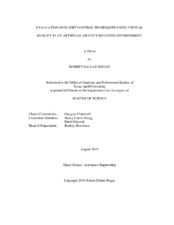Evaluation of Flight Control Techniques Using Virtual Reality in an Artificial Gravity Rotating Environment
Abstract
The purpose of this thesis is to develop a collaborative virtual reality (VR) engineering platform for space system and mission design and to demonstrate its utility in the context of evaluating human interfaces for future control systems. Much of the work for this project was the development of the platform itself (called SpaceCRAFT). Additionally, a user study was done with 33 subjects to examine the potential advantages of designing and testing systems in virtual environments that otherwise may be difficult to replicate on Earth. The task evaluated was flying a drone in a rotating artificial gravity environment, which involves numerous unfamiliar forces. Different control strategies were tested using VR in comparison to flat screen interfaces. This particular challenge was chosen to emphasize the difference between immersive and non-immersive environments, and the results demonstrate that VR is a promising tool for human-interface system design and evaluation. The 50-meter radius space station simulated an open-air, long-term habitable environment and was designed with considerations of human factors for rotating reference frames.
A quadrotor control model was developed and simulated a variety of stabilization and sensitivity modes. Subjects piloted the drone through an obstacle course to evaluate flight characteristics for each configuration. The Modified Cooper-Harper Rating Scale for Handling Qualities was used to measure participants’ subjective rating of these characteristics. The average rating on the 10-point scale was 0.24 points better using VR over traditional monitor viewing. Objective performance based on displacements from the path was measured to be up to 11% more favorable for VR with 95% confidence. Both of these results indicate advantages for user preference and user performance while utilizing immersive simulations. No notable correlations were found between experience levels.
Subject
Virtual RealitySpace System Design
Space Mission Analysis
Flight Control Systems
Artificial Gravity
Quadrotor
User Study
Modified Cooper-Harper
Unreal Engine 4
Citation
Hogan, Robert Dallas (2019). Evaluation of Flight Control Techniques Using Virtual Reality in an Artificial Gravity Rotating Environment. Master's thesis, Texas A&M University. Available electronically from https : / /hdl .handle .net /1969 .1 /186587.


